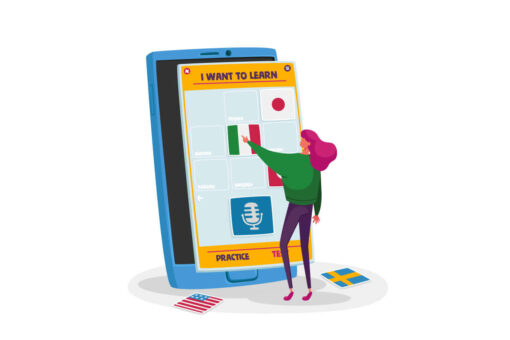Is coronavirus installing Higher Education 4.0?
Comment taken from ‘Educational Technology’ (click here to see it)

Designed by iconicbestiary / Freepik
Universities carry a long pedigree of tradition. New ideas come, old systems go. But the trademark experience of lectures, libraries and labs has remained a cultural constant in higher education for centuries. Well, until a few months ago. Mass transitions to remote teaching, online assessment and video research conferences have been a triumph of will. It’s ignited a spirit that universities can be responsive in the face of gargantuan trials. It’s shown the determination of students and staff to ‘keep calm and carry on’.
Yet, step back from the precipice and we see the plunge into lockdown may have triggered a new modus operandi that has been brewing in higher education for years – Higher Education 4.0. Artificial intelligence, big data analytics, adaptive media and virtual reality – the future of digital learning carries tremendous promise, with new affordances, new pedagogies, and tech personalisation on a scale not seen before. The scalability of these technologies is colossal for global higher education.
An edtech revolution
Such ambitions may seem a far cry from the immediate crisis. Just being operational with any online provision would satisfice most universities at present. Transferring entire programmes into blended offerings within a few months will shake the sector. But in doing so, the seeds of revolution are watered and we will do well to think about the medium-term in this new reality as well as the imminent. If the previous industrial revolutions taught us anything, it’s to move with the times, for the times they are a-changin’.
The JISC Digital Experience Insights Survey 2019 demonstrates the value university students place on digital education: 76% agree they more easily fit learning into life, while 75% felt they were more independent in their learning. All of this is perhaps unsurprising from a generation enjoying a staple diet of YouTube, TikTok and Snapchat.
Student attitudes continue to shift in that direction too – as comparative data from the JISC research uncovers. In 2018, 32% of university students said they wanted more digital technologies in their course. By 2019, that figure had risen to 44%! Evidently, the unlocking of Higher Education 4.0 will be a welcomed entry for digital natives in search of a better educational life.

It ain’t plain sailing!
But the dawn of a digital horizon is not trouble free. The lack of stable Wi-Fi on campus as much at home remains a perennial issue. Inequalities around laptops and hardware create an unlevel playing field for learning and assessment. And then there is the uncertainty over communities of practice. Stimulating belonging and inclusivity are possibly the biggest challenges to the student experience in online and blended education.
For staff, there may be others feelings of concern. There is willingness to try new technologies, yet ambivalence, indeed anxiety, with the unfamiliar. While some academics applaud the opportunities for new technologies, others feel concern at the swelling set of expected competencies and workloads. The coronavirus context has no doubt given impetus to digital upskilling. But concerns around data security, invasions of privacy and the changing nature of work remain and require more critical engagement.
Pedagogical perks
In the digital age, the competencies of pedagogy take on new demands. The trend towards video-recorded mini-lectures is just one step towards the automation of existing curriculums that rely on one-way knowledge transmission such as lectures. With carefully crafted social learning activities, quality learning media and good analytics, machine learning can swiftly take these into a more personalised, adaptive educational journey for students. In this space, pedagogy becomes more about design, media and online social facilitation than lectures, slides and subject mastery. Subject mastery will of course remain critical, but be delivered as part of research and knowledge dissemination events integrated into courses, much like open-access research seminars. Qualities such as empathy, care and coaching also gain critical ascendancy: these are the relational interactions that artificial intelligence will struggle to deliver on (at least for the time being).
To be or not to be digital, then, is not the question. The coronavirus has shown that digital education is no longer confined to ‘distanced’ online learning programmes. It permeates all: blended is the new normal. Demands for quality learning media and interactive digital experiences will only increase in the post-coronavirus world – for all students, including those taking ‘face-to-face’ courses. The question for most institutions is, how do we enable this transition to happen?
In a recent article for the Times Higher Education, David LeFevre outlined a helpful three-stage plan for dealing with the existing crisis. Stage 1: stabilise through synchronous online teaching. Stage 2: enhance by delivering quality online courses with a greater focus on asynchronous activities and digital learning communities. Stage 3: innovate by embracing new pedagogies, new technologies and new methods, as this may mitigate the delivery challenges in the years ahead. It’s this third stage that will drive long-term impact through the adoption of EdTech.
But transitioning to Higher Education 4.0 will require deeper institutional change as well. Executive leaders get this. Most universities have thought-through digital strategies that account for the evolving socio-technological context. The challenge for universities in a competitive environment is speed. Here, the barrier is more about workplace structures and cultures than it is about planning and pedagogy.

Agility is key
All universities are wonderful yet clunky systems. They are built around quality and rigour rather than service innovation. It’s interesting to note that few universities have designated research and development (R&D) departments for service innovation on their core product: education. They are designed to be stable rather than adaptive. This is their tradition: professional bureaucracies built for rigour, standards and status. But while a level of bureaucracy is important to safeguard compliance and quality, traditional structures may struggle to sustain a sector on the cusp of digital revolution.
To make the transition into EdTech, we need agility. Leaders that understand the signals of change and mobilise a shared vision will take us forward. But it’s the practical implementation where the test will be. Redefining roles, responsibilities and career structures to recognise and reward technological proficiency. Building networks of teams across the institution – with students as partners – to champion digital fluency. Empowering middle managers to invest in creative projects and intrapreneurs through easy to access buy-out schemes and financial support. Recognising I.T. departments are no longer back office support: they are delivering a core part of the educational product. Making adaptability part of the institutional discourse.
Agility also means stimulating a connected eco-system. Building fresh collaborations not merely across departments, but across the sector, and critically, across sectors – public, private and non-profit. Indeed, startups and established players will play a key role in supporting EdTech development. For comparison, just look what FinTech has done for the financial service industry. New startups are already entering the EdTech arena, offering exciting new platforms, content provision and analytics. A burgeoning eco-system may be the driver that takes education to new heights and new realms globally. It needs to. For there are a great many people in this world in need of higher education opportunities.
When the coronavirus passes it is likely universities will get a surge in student numbers, as the economic woes drive people back to education. Higher Education 4.0 will not be fully installed by then. But innovation, collaboration and institutional change will be happening. We have entered a new normal. The trigger has been pulled. The times they are a-changin’.

Ivan Mitchell is Associate Professor at the University of East Anglia and CEO of Studious Digital Education, a social enterprise that supplies high-end digital learning and platforms to universities.
Other articles

6th Oct, 2021
Blended learning for languages can boost student engagement
Blended Learning: What Is It? As the name suggests, blended learning blends different learning methods. Essentially, blended learning combines traditional in-classroom teaching/learning with technology-based self-study outside of the classroom. The second part of the blended learning approach, the technology-based e-learning component, can offer real support for language learning. The internet has a wealth of resources, […]

13th Sep, 2021
ESTU + Studious - new partnership!
We are delighted to announce Estu+Studious: a new partnership with ESTU as part of our new corporate services development. Working with Simon Littlewood and Karl Eddy of Estu, Studious will deliver tailored learning solutions available for use in Apprenticeship Levy schemes to major corporations. The content delivered by Studious will be suitable for Learning […]

4th Aug, 2021
Tone of voice: what is yours?
How to use the top brands’ comms tactic to engage students with your online educational content Fast forward to September 2021: after weeks spent preparing classes, creating activities, developing quizzes and choosing case studies, you still have more videos and microphones turned off during your online lecture than you would like. How can […]

